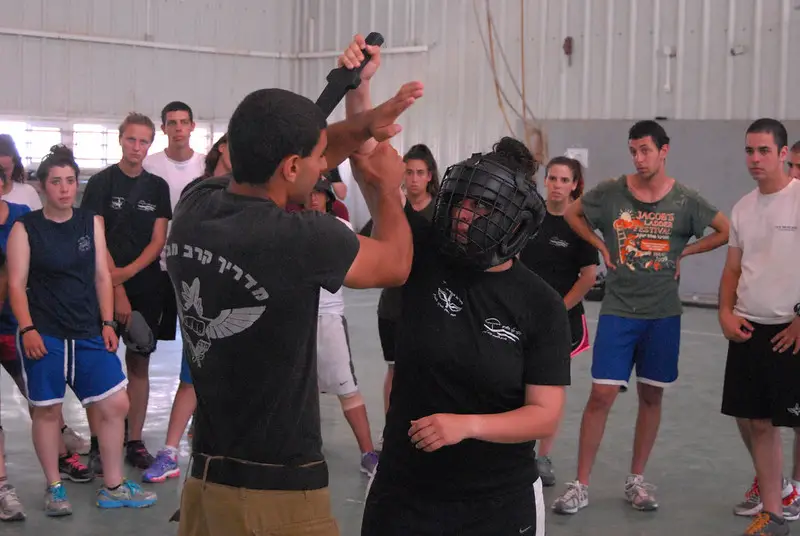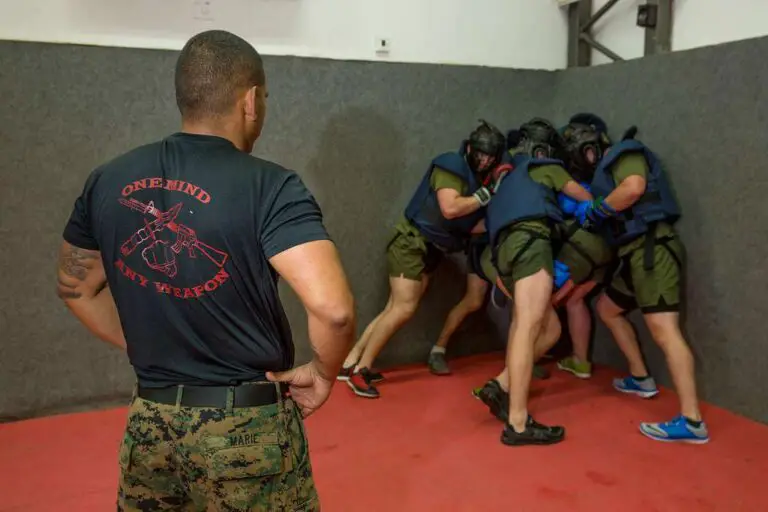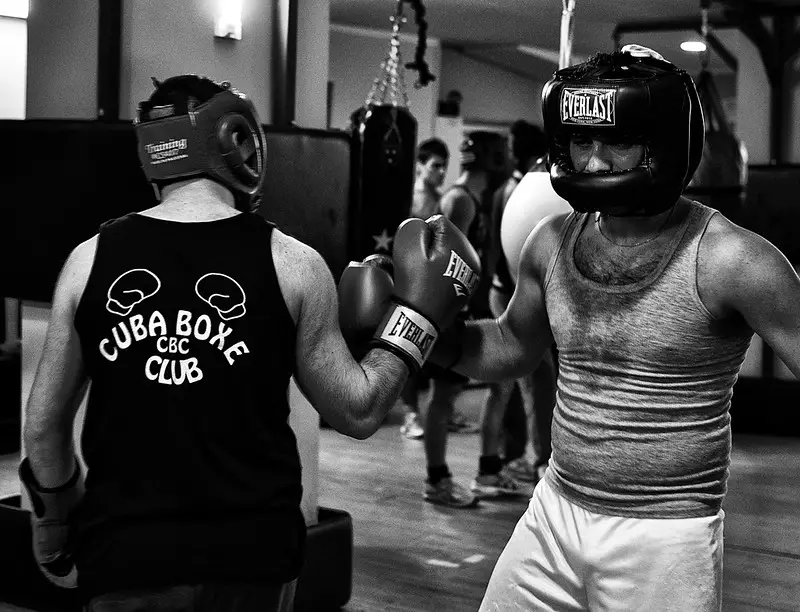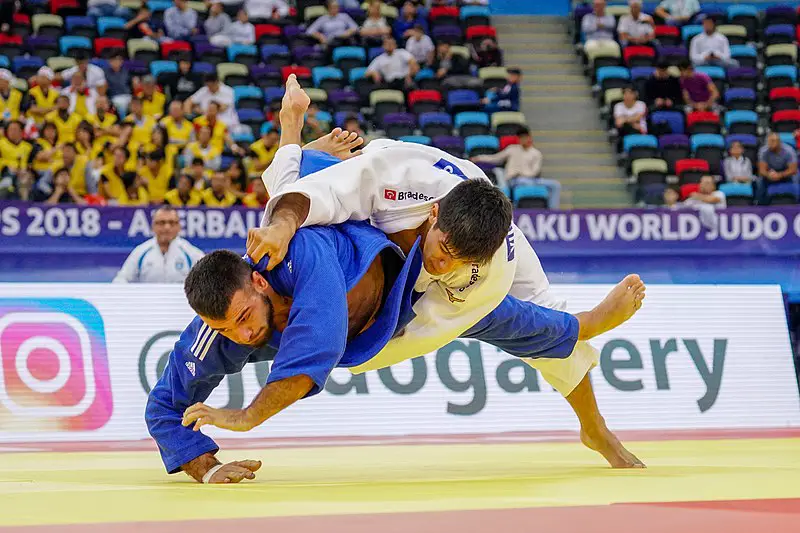The term “best military martial arts” can be subjective. It is based on various factors such as specific goals and context.
In this article, you will discover the 10 best military martial arts overall, which militaries are using them, and learn more about the concept of each one.
10. KAPAP — Israeli Special Forces
KAPAP (Krav Panim el Panim) is a military martial art that originated in Israel. Israeli special forces units created it by mixing techniques from multiple systems such as:
- Krav Maga
- Brazilian jiu-jitsu
- Judo
- Boxing
Its techniques are simple, instinctive, and easy to learn, making them suitable for military personnel with varying levels of experience and physical ability.
In addition to unarmed combat techniques, KAPAP includes training in the use of weapons such as knives, sticks, and firearms. Soldiers learn how to defend against armed attackers and how to use improvised weapons to their advantage in combat situations.
They also practice responding to a variety of threats and scenarios, including ambushes, hostage situations, and urban warfare scenarios.

9. Sanshou — Chinese Military
Sanshou (Sanda), is a Chinese martial art and combat sport developed by the Chinese military. It combines elements of traditional Chinese martial arts (Wushu) with modern self-defense techniques.
People also refer to Sanshou as “Chinese kickboxing”. However, its origins are in the military. The military variation primarily focuses on practical combat techniques rather than standardized forms or routines. It emphasizes strikes, kicks, throws, sweeps, and takedowns, as well as clinch fighting and grappling techniques.
The majority of these techniques originate from popular combat systems such as:
- Boxing (punches)
- Kickboxing (kicks and punches)
- Wrestling (Takedowns)
In addition to being one of the best military martial arts, Sanshou has also evolved into a popular combat sport with organized competitions at both national and international levels. These competitions feature rules similar to other full-contact combat sports, with points awarded for clean strikes, takedowns, and effective techniques.
8. The Modern Army Combatives Program (MACP) — US Army
MACP is a martial arts training program developed by the United States Army in 1995. It was created to improve soldiers’ hand-to-hand combat skills, physical conditioning, confidence and leadership skills.
MACP draws heavily from the principles and techniques of Brazilian Jiu-Jitsu, particularly its focus on ground fighting, submission holds, and grappling. The legends Rorion and Royce Gracie personally contributed to the development of MACP in the 90s.
This emphasis allows soldiers to effectively control and subdue opponents while minimizing the risk of injury.
The system employs a progressive training curriculum that begins with basic techniques and gradually advances to more complex skills and scenarios. Soldiers learn a range of techniques for both offensive and defensive purposes, including striking, takedowns, joint locks, chokes, and ground control.
Next, MACP places a strong emphasis on realistic training scenarios to simulate combat situations. Soldiers engage in sparring sessions, drills, and scenario-based training exercises to develop their skills and test their abilities under pressure.
The Army offers a certification program for soldiers who wish to become MACP instructors. These instructors undergo specialized training to teach MACP techniques to their fellow soldiers, ensuring widespread proficiency and consistency across units.
7. Lerdrit (Muay Lerdrit) — Royal Thai Army
Also known as “Muay Lerdrit”, Lerdrit is a traditional martial art from Thailand that has been adapted for military training purposes. Developed from ancient Muay Thai techniques, Lerdrit places a strong emphasis on practical self-defense, hand-to-hand combat, and unarmed combat techniques.
Like most other best military martial arts, it is a hybrid combat system. Trainees learn grappling, striking, and clinch fighting against armed or unarmed opponents. Due to its heavy Muay Thai influence, the emphasis is on advanced striking techniques such as kicks and clinch control.
However, these moves need to be adapted to real-life situations. For instance, the military needs to quickly neutralize the threat with a minimum risk of injuries in certain situations.
It provides soldiers with the skills necessary to defend themselves and engage adversaries in various combat situations, including urban warfare, crowd control, and defensive tactics.
While Lerdrit is commonly associated with military and law enforcement training, it is also practised by civilians interested in self-defense and personal protection. The principles and techniques learned in Lerdrit can be applied in various real-world situations outside of combat scenarios.
6. Systema — Russian Military and Law Enforcement
Systema is a Russian military combat system. What MCMAP is in the US, Systema is in Russia.
It is also a hybrid system that involves striking, grappling, weapon-based training and many other skills suitable for military and special forces. Russian counter-terrorism special forces “Spetsnaz” regularly train in Systema to improve their combat abilities.
Systema training typically involves a holistic approach that focuses on developing adaptability, fluidity of movement, breath control, and relaxation under stress.
On paper, systems use conventional martial arts techniques. However, trainees learn how to respond dynamically to unpredictable situations. Real combat is not a ring so trainees must have the ability to adapt to different scenarios.
Unlike many martial arts that emphasize tension and power, Systema emphasizes breath control and relaxation under stress. Practitioners learn to maintain calmness and control their breathing even in high-pressure situations, enhancing their ability to remain focused and make effective decisions.
5. Teukgong Moosool — South Korean Military
Tukong Moosul is a martial art developed by the South Korean military. It integrates elements from various traditional Korean martial arts such as:
- Taekwondo
- Hapkido
- Judo
- Boxing
- Techniques adapted from other martial arts systems.
The primary focus of Teukgong Moosool is on practical self-defense and combat techniques. It emphasizes punches, kicks, joint locks, throws, and ground fighting techniques.
The system is characterized by its structured curriculum, which progresses through various levels of proficiency and incorporates both empty-hand techniques and weapon training. It places importance on physical conditioning, flexibility, agility, and mental discipline.
In the military context, Teukgong Moosool trains soldiers in hand-to-hand combat and self-defense techniques. It provides soldiers with the skills and confidence needed to defend themselves and neutralize threats in combat situations.
4. Filipino Martial Arts (FMA)
FMA encompasses various martial arts styles from the Philippines, including Eskrima, Arnis, and Kali. These arts emphasize weapons training (such as sticks, knives, and bladed weapons) as well as empty-hand techniques, making them well-suited for military personnel who may encounter armed adversaries.
One of the distinctive features of FMA is its emphasis on weapons training. Practitioners are trained extensively in the use of various weapons such as sticks, knives, and bladed weapons.
This focus on weapons proficiency not only equips military personnel with the skills to defend against armed adversaries but also provides them with valuable insights into weapon handling, tactics, and strategy.

Moreover, FMA’s focus on principles rather than rigid techniques allows practitioners to adapt and innovate based on the demands of the situation. This flexibility is particularly advantageous in dynamic and unpredictable combat environments, where quick thinking and improvisation are essential for survival.
The fluidity of movement, adaptability to various combat scenarios, and emphasis on efficiency make FMA a valuable asset for soldiers, law enforcement officers, and security professionals worldwide.
3. Combat Sambo — Russian Military
Combat Sambo is a Russian military martial art developed in the 1920s. The two founders were:
- Viktor Spiridonov
- Vasily Oshchepkov
Combat Sambo integrates techniques from various martial arts, including judo, jiu-jitsu, wrestling, boxing, and traditional Russian folk wrestling styles. This blending of techniques allows practitioners to be versatile and adaptable in different combat scenarios.
On top of that, trainees learn how to attack vital points and use dirty moves such as eye-gouging, and striking the throat and groin area. The learning curriculum also includes weapon-based training against knives, guns, and other weapons.
Combat Sambo techniques are simple, direct, and easy to learn, making them suitable for soldiers with varying levels of martial arts experience. Tranees learn how to execute each technique in an aggressive and explosive manner to neutralize the threat as fast as possible.
That’s why MMA fighters trained in Sambo are so aggressive and explosive inside the cage.
There is also a sports variation called “Sports Sambo” that primarily focuses on grappling without striking.
2. MCMAP (Marine Corps Martial Arts Program)
MCMAP was developed by the United States Marine Corps. It is a hybrid combat system that integrates techniques from various grappling and striking arts. This includes:
- Judo
- Karate
- Jiu-jitsu
- Wrestling
- Krav Maga
MCMAP is effective due to its real-world combat orientation, realistic training, and versatility that covers a lot of scenarios soldiers may face in real life. It trains soldiers to deal with adversaries in confined spaces, urban environments or shipboard settings.
Most importantly, the system includes only the most effective skills and techniques. There are no rules to follow. Each technique is broken down and adapted to the military combat needs so the effectiveness is under no question.
MCMAP is designed to meet the needs of military personnel. It emphasizes combat effectiveness in real-world scenarios encountered by Marines, such as:
- Close-quarters combat
- Weapons retention
- Defensive tactics in combat gear
Next, the program’s focus on physical conditioning ensures that Marines possess the strength, endurance, and agility required for combat operations. They do drills and exercises specific to military tasks, such as carrying gear or navigating obstacles.
Also, the mental aspect of combat training is equally important. Through different drills, Marines learn how to stay composed under pressure and make rational and effective decisions to deal with the threat in the most efficient way possible.
1. Krav Maga — Israeli Defense Forces (IDF)
Developed by the Israeli military in the 1950s, Krav Maga is among the best military martial arts. It entirely focuses on real-world armed and unarmed combat, without any competition or rules.
Its focus on instinctive movements and effective techniques aligns with the need for soldiers to react rapidly and decisively in high-pressure situations.
The emphasis is on direct techniques, attacking vital points, situational awareness, and doing anything in your power to protect yourself.
As such, Krav Maga’ covers various scenarios. This includes close-quarters combat, defense against multiple attackers, and weapon disarming. This makes it one of the best military martial arts in diverse operational contexts.
Training is intense and realistic. Through rigorous drills that simulate real-world combat scenarios. Trainees engage in high-intensity exercises, sparring sessions, and simulations of armed and unarmed confrontations to develop quick reflexes, physical endurance, and mental resilience.
Bonus: Brazilian Jiu-Jitsu — Military and Law Enforcement
BJJ is a grappling martial art that focuses on ground fighting and submission holds. It’s effective for controlling opponents and subduing them without causing excessive harm.
This approach makes it quite suitable for military and law enforcement applications.
BJJ represents an ideal balance between the effectiveness and risk of injuries. It enables the soldier or police officer to neutralize the aggressor effectively without causing serious injuries. They can achieve this through leverage, positioning, and joint manipulation.
On top of that, BJJ is all about weight distribution, leverage, and technique. This enables individuals to deal with people who are bigger in size and strength but lack grappling technique. This makes it ideal for the military where you need to deal with people of different sizes.
BJJ training is intense and realistic through structured sparring sessions, known as “rolling,”. This is where practitioners apply techniques in live scenarios against resisting opponents. This hands-on approach fosters adaptability, timing, and problem-solving skills under pressure.
Also, the physical demands of grappling and the competitive nature of training sessions contribute to a high-intensity learning environment. Practitioners are well-prepared for the challenges they may encounter in military or law enforcement settings.


